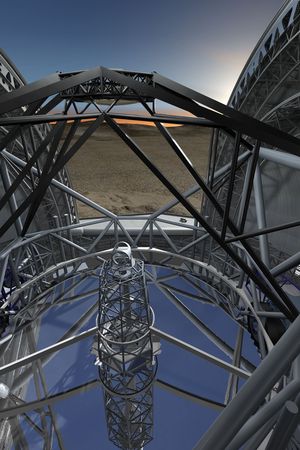Technology
The Telescope
To make a telescope of this size and accuracy the engineers need to push the boundaries of their techniques to the limit. They are using cutting edge technology and developing new methods to solve the challenges presented by such a massive project. For example, the main mirror of the telescope will be made up of 800 hexagonal mirrors, each of 1.4m in size, all of which need to be controlled independently. Another mirror, 2.5m across, will correct for the turbulence of the atmosphere by changing its shape over 1000 times per second.
Instruments
A key part of the telescope are the instruments which are the eyes of the telescope, converting the light that is collected by the mirror into images and spectra that astronomers will use to answer some of the biggest questions in science today. Eight potential instruments have been designed to address different questions. Two of these concepts have been selected as the first instruments, with the design study for one of these led by the UK. The instruments will sit either side of the telescope, on large platforms each of which is as big as a tennis court. Engineers from across the country have been involved in these studies, ensuring that astronomers in the UK will have access to the tools by which we can unlock some of the greatest mysteries of the Universe.
Instrument concepts with UK involvement
UK astronomers and engineers have a long history in building successful instruments for the world's leading telescopes both on the ground and in space. Building on this heritage and experience, UK teams have performed detailed studies of instruments to be used with the E-ELT. Among the eight instrument concept studies commissioned by ESO, the UK is involved in six and in three of these UK scientists are taking a leading or major role. These instruments have distinct but complementary modes that enable a wide range of science questions to be addressed. We list the instruments below but please follow the links to obtain a more detailed overview on each instrument individually.
The instruments the UK is working on include a spectroscopic capability, in which the UK has extensive engineering experience. Spectrographs take the light collected by a telescope and split it by wavelength. How finely the light is split into chunks (or bins) of wavelength determines the spectral resolution, i.e. the smaller the wavelength bin the higher the spectral resolution. The spectra of star and galaxies hold a wealth of information revealing the nature of the objects they are looking at and their chemical composition. For example, the spectra of stars in the Milky Way tell astronomers the ages, masses, type and evolutionary state of stars. The spectra of galaxies also tell astronomers how distant the galaxies are, what their stellar population is made up of and how the stars and gas within galaxies move.
Of the instruments the UK is involved in, the spectrographs take spectra of individual objects or small fields (HARMONI, CODEX, METIS, EPICS) and others can observe multiple objects simultaneously (EAGLE, OPTIMOS-EVE). Some also have the capability to take images (METIS). It is also possible to combine imaging and spectroscopy into what is called integral field spectroscopy. This effectively means for every pixel in an image a spectrum is simultaneously obtained (HARMONI, EAGLE, METIS, OPTIMOS-EVE). This provides spatially resolved spectroscopic information. For example, one can observe gas clouds surrounding star forming regions and look for signatures of how that gas is moving. EAGLE will be able to conduct integral-field spectroscopy of multiple fields simultaneously.
The telescope and the instruments will also use adaptive optics that is a means of overcoming the blurring of light from stars and galaxies caused by turbulence in the Earth's atmosphere. It improves the spatial detail we can observe as well as allowing us to see light from fainter objects than would normally be possible. With adaptive optics and a primary mirror of over 39m, will give us sensitivity that would be equivalent to seeing the flame of a candle on the moon! There are several flavours of adaptive topics that will be used on the telescope. Part of the EAGLE instrument team is looking into a novel mode of adaptive optics that uses multiple objects to determine the turbulence in the atmosphere. This allows the effects of atmospheric turbulence to be corrected over large fields of view. CANARY is a test-bed for this multi-object adaptive optics system that is being tested on the 4.2m William Herschel Telescope on La Palma in the Canary Islands.
HARMONI - Single Integral Field Spectrograph in the optical-to-near-infrared wavelengths
EAGLE - Multiple-Integral field near-infrared spectrograph
OPTIMOS-EVE - Multi-object spectrograph using optical fibres in the optical-near-infrared
EPICS - Planet Imaging spectrograph and imaging polarimeter with extreme adaptive optics
METIS - Mid-infrared imager and spectrograph
CODEX - High resolution and high stability visual spectrograph
CANARY - an open loop multi-object adaptive optics system
| << Home | < The Telescope | Technology |
> Science |



